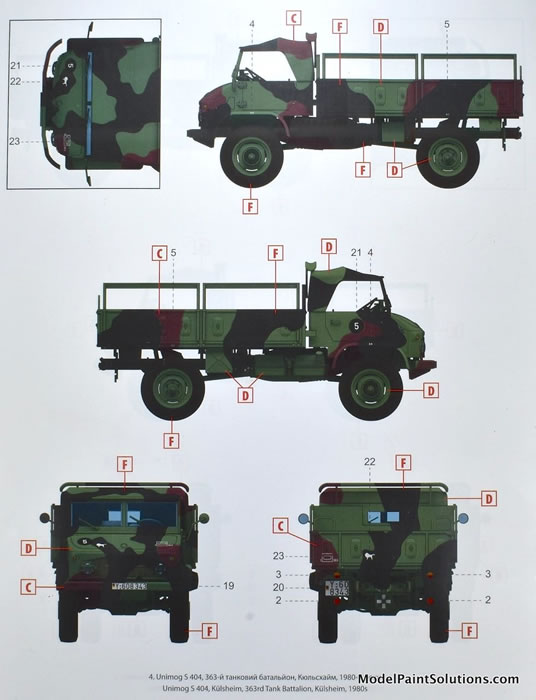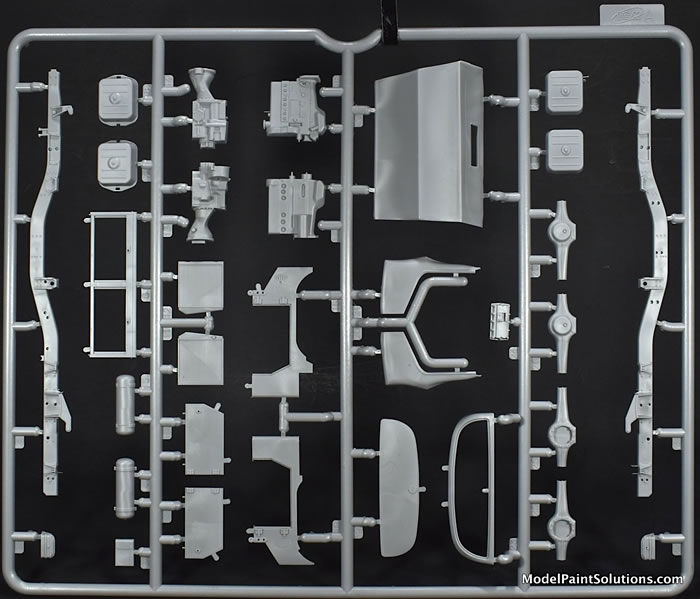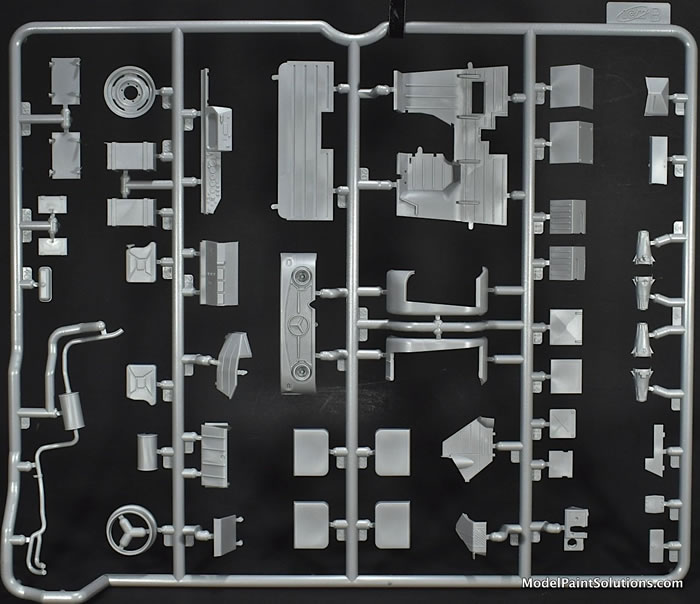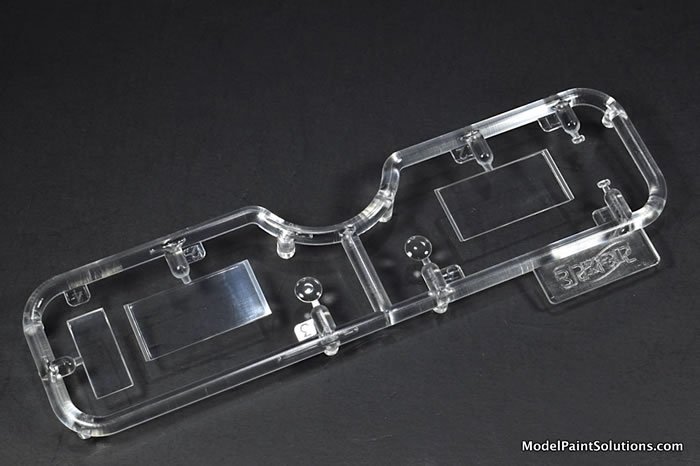|
|
|
|
Unimog S 404
ICM, 1/35 scale
Reviewed by John Miller

Summary
| Stock Number and Description | ICM Item No. 35135 - Unimog S 404 |
| Scale: | 1/35 |
| Media and Contents: | ~116 parts in grey styrene, 7 clear parts, 5 vinyl tires, and one decal sheet with markings for 4 vehicles. |
| Price: | |
| Review Type: | First Look |
| Advantages: | New mold kit with ample, scale-appropriate detail, poseable doors/lids, and quality decals. |
| Disadvantages: | There are multiple small pieces held by large sprue gates requiring effort to remove and re-fresh. |
| Recommendation: | This is a nice kit that will build into a very convincing model. |
Introduction
I had the opportunity to see one of these hummers close up years ago and it left a lasting impression; very cool vehicle. And so it was with a knee-jerk reflex that I reached out and grabbed one on the way through my local hobby shop, Skyway Models. No regrets; the fidelity of detail is amazing on this kit. Keep ‘em coming ICM!
Background
The Unimog 404, also called the Unimog S and Unimog 404 S, is a vehicle of theUnimog series by Mercedes-Benz, produced in the Unimog plant in Gaggenau from 1955 to 1980. Marketed as Unimog U82, and later Unimog U110, 64,242 units of the two Unimog 404 types 404.0 and 404.1 were built, which makes the 404 the Unimog model with the highest production figure of all Unimogs. Unlike the Unimog 401, the 404 is rather a small 1.5-tonne-offroad-truck than an agricultural vehicle. In Germany, it was a common military vehicle and fire engine. 36,000 Unimog 404 were made for the Bundeswher.

The first Unimog 404 concept-vehicle was made in 1953 and was slightly smaller than the series production model, it had a track width of 1,600 mm (63 in) and a wheelbase of 2,670 mm (105 in). Two prototypes for the French army followed in 1954, the first 1,100 series production models were also purchased by the French army. Since the French army did not want the spare wheel to occupy space for soldiers on the bed, the Daimler-Benz engineers decided to build the Unimog 404 with a downswept frame so the spare wheel could be mounted underneath the bed. This constructional feature also allowed more torsional flexing and, therefore, improved the off-road capabilities of the Unimog. Later, the downswept frame became a key constructional feature for the following Unimog types.
At its introduction in 1955, the Unimog 404.1 was available as the 2,700 mm (106 in) wheelbase model with the Otto engine M180 producing 60 kW (80 hp; 82 PS). In 1956, the 2,900 mm (114 in) wheelbase model of the 404.1 followed, available with the same engine. Both were sold as Unimog U82. The production of the U82 with the short wheelbase was stopped in 1971, while the long wheelbase model was built until 1980. Starting from 1971, the Unimog 404.0, sold as Unimog U110, was offered. It was fitted with the cab of the Unimog 406 and soon afterwards, with the model 404.012, it received the M130 engine. However, only 1,791 404.0 were made. Also, 81 Unimog 404 were made with the diesel engine OM165 (44 kW (59 hp; 60 PS)) for the Portuguese market.
Technical Description
The Unimog 404 is a small four-wheel off-road capable truck designed for a payload of 1,500 kg (3,307 lb). Like other Unimogs, it has a ladder frame, two portal axels with reduction gears and coil springs with hydraulic shock absorbers for the rear and front axle. All four wheels and tires have the same size and are fitted with hydraulic ATE drum brakes. The 404 is a rear-wheel-drive vehicle with switchable all-wheel-drive and additional differential locks. A water-cooled straight-six Otto engine type M 180 II-U, displacing 2,195 cc (134 cu in) powers the 404.1. It is fitted with a Zenith 32 NDIX off-road-carburetor and transmits the torque to a fully synchronized manual Daimler-Benz-six-speed-gearbox with two additional reverse gears. For a clutch, the Fichtel & Sachs K 16 Z single-disc is used. The 404 was available both with a standard closed two-door-cab and as a two-door-cabriolet with a convertible top. The 404.1 has a divided windscreen, while the 404.0 with the cab of the Unimog model 406 has a single windscreen. Only the standard cab models have side windows in the doors. Special purpose vehicles, such as fire engines, were also made with an extended four-door-cab.
F i r s t L o o k
Inside the doubled-lidded, heavy cardboard box we’ve come to expect from this manufacturer are 6 sprues of grey styrene, one of clear, 5 vinyl tires, and decals for 404’s. Initial impressions are very positive. The fidelity of detail on the smaller parts is just awesome. That said, some of the sprue gates holding those beautifully molded parts are a bit large so careful work with a blade, files, and sand paper will be required for removal and re-freshening. The tires (5) are very nicely molded with the sprue attach points buried amongst the treads. The clear parts are crisply molded and crystal clear. This is a beautiful kit that screams complex so a good bit of study with the instructions prior to committing with glue is well advised.
Assembly starts with the H-frame chassis that incorporates 10 separate cross-braces. Once completed, the H-frame is the primary assembly that all subsequent parts are added to starting with the beautifully molded Mercedes engine-transmission.
The engine is crisply molded with separate accessory belts/pulleys, and a cooling fan. The detail here is quite impressive. Moreover, the engine lid can be posed open permitting this detail to be seen when the model is assembled; very nice.

Next up is the single-piece exhaust, gas tanks (from halves), transaxle, and storage bins thereby completing most of the major chassis assembly.
The cab is next in sequence assembled from multiple pieces all beautiful molded with in-scale corrugated details. Cab details include a circuit breaker box, instrument panel (augmented with dial faces from a decal), floor pedals, center console, and very finely detailed steering wheel. Like the engine, much of this detail will be seen as the doors can be posed open during assembly.

With the addition of multiple handles, braces, and clear windscreen the cab is largely complete. Addition of the nicely molded fabric top, comprised of three pieces completes the cab which is then joined to the H-frame chassis. The truck bed, composed of ~22 separate pieces, is assembled next and here too the surface details are just waiting for paint and a wash.
After the bed is added to the chassis, the tires/wheels are next up and as throughout the entire model, the details are beautifully rendered starting with the exposed brake assemblies.

Once the 4 tires and one spare are added, there’s just a few small external hand-holds, rear-view mirrors, and various details left to add to call ‘er done.

I see no red-flag moments in the assembly. Many of the parts are small so I’d expect some of the sub-assemblies to be on the finicky side. That said, I see nothing that couldn’t be dealt with using just patience and a slow, carful approach.
Markings
The decals, by ICM, are crisply printed with good color density.

Markings are provided for 4 vehicles as follows:
-
Unimog S 404, Bundeswehr, Upper Bavaria, 1970’s.
-
Unimog S 404, German Air Force, 74th Fighter Squadron, Neuberg, 1970.
-
Unimog S 404, 5th Artillery Training Regiment, Idar-Oberstein, 1970.
-
Unimog S 404, Külsheim, 363 Tank Battalion, 1980’s.
C o n c l u s i o n
This is a nice kit that will build into a very convincing model. Extra time spent on the engine compartment and cab will be paid off by the ability to pose both the engine lid and cab doors open. Some time might be spent cleaning up a wealth of small parts held by large sprue gates but the effort will be well worth it.
Keep ‘em coming, Roden!
Thanks for reading along,
—John
Kit eagerly purchased by reviewer; yes, again.
For more on this review visit Modelpaintsolutions.com.
https://modelpaintsol.com/reviews/icm-35-unimog-s-404-35135
Text and Images by John Miller
Page Created 4 December, 2022
Page Last Updated
4 December, 2022












